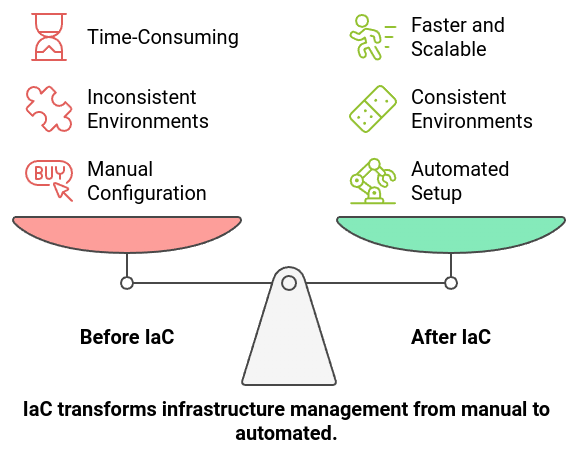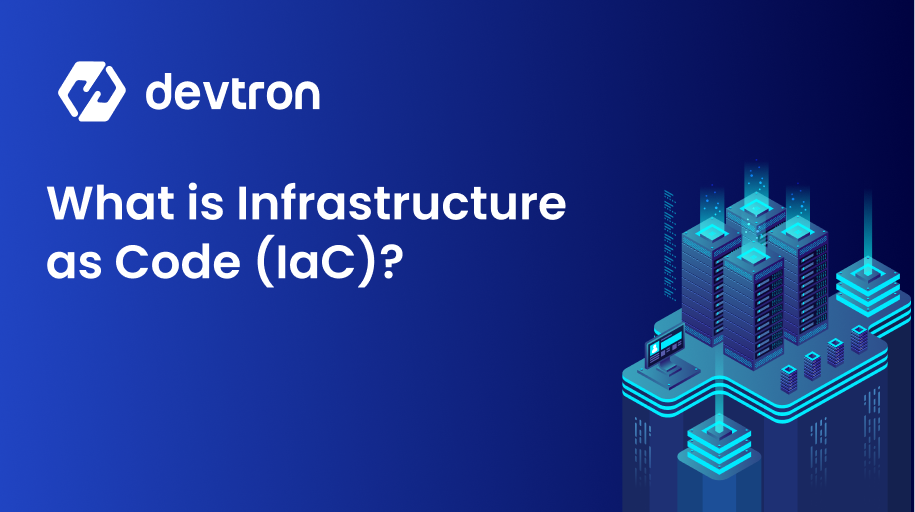Creating and configuring the infrastructure can be very tiresome and time-consuming the moment you are doing it manually. Imagine configuring servers, databases, networks, or storage multiple times; one slip can disrupt it all. Having a single mistake can lead to a cascade of failures and this is even more troublesome when you have to repeat the process multiple times. Actually, it’s very similar to constructing a house without a plan, nothing fits together properly, and it's hard to keep things organized. This is where Infrastructure as Code (IaC) makes this much easier.
Infrastructure as Code can be best described as writing a recipe to create and configure infrastructure in a specific way. Instead of manually logging into each server, configuring settings, and adjusting network rules one by one, everything is defined in configuration files. These files provide the single source on your setup and offer the guarantee each time that you create a build there will be no mistakes.
As a result, when it comes to environments, Infrastructure as Code (IaC) makes setting up environments quick, consistent, and even automated. It also makes fixing or scaling your setup easy because you can just adjust the code, and then run it against your system. For developers, this means spending less time fixing infrastructure issues and more time creating and improving apps.
In this blog post, you'll discover what Infrastructure as Code (IaC) is, how it changes the way we manage infrastructure, and how you can start using it to simplify your own infrastructure.
Why Infrastructure as Code (IaC)
Think about the last time you had to set something up, maybe it was cooking a recipe. Now imagine doing it without clear instructions. Each attempt might turn out differently, and if you need to make the same setup multiple times, it quickly becomes exhausting. That’s exactly what managing infrastructure feels like when done manually; every server, database, and network configuration needs to be recreated from scratch, and it’s easy for things to go wrong.
This is where Infrastructure as Code (IaC) becomes a lifesaver. With Infrastructure as Code, you’re writing a step-by-step guide for your infrastructure. Instead of manually clicking buttons or running commands, you create a file that describes everything your system needs, from servers to network rules. It’s like having a recipe that guarantees your setup turns out perfectly every single time.
Why does this matter? Because consistency is key. For example, you’re setting up a testing environment, adding more resources to handle extra users, or fixing an issue in your app. Without consistency, each setup in different environments might behave differently, leading to unexpected problems. With Infrastructure as Code (IaC), you create a reliable, repeatable process. Every environment is set up exactly the same way, every time, ensuring things work smoothly and predictably no matter what changes or challenges arise.
And it’s not just about getting things right, it’s about saving time and energy. Developers can spend less time on frustrating setup tasks and more time on what really matters: building and improving their apps.

How Infrastructure as Code (IaC) Works
We already know by now that Infrastructure as code (IaC) uses code to provision infrastructure. The infrastructure contains resources like servers, databases, networks, and storage. Infrastructure as Code (IaC) does this by defining infrastructure in configuration files, which act as a blueprint for the desired state of the architecture. These configuration files are stored and managed as code, enabling version control, collaboration, and consistency across environments.
Here’s a breakdown of how it works:
Developers Write Code:
Developers write Infrastructure as code (IaC) in YAML, or other Domain Specific languages and, instead of manually configuring servers, the code is run. This code determines what the infrastructure does (who owns it) and how it operates (i.e. number of servers, networks, and storage).
Version Control:
The written code is stored in a version control system, like Git. This makes it easy to track changes, collaborate with others, and revert to previous configurations if needed.
Push or Pull Mechanism:
Once the code is written and stored, it is either "pushed" to or "pulled" by an automation tool or server. This tool reads the instructions in the code.
Automation Tool (API or Server):
This is the brain of the Infrastructure as Code (IaC) process. Tools like Terraform, Ansible, or Puppet read the code and use APIs to create or update the infrastructure. The automation ensures that everything is consistent and error-free.
Deployment:
The automation tool can manage infrastructure in both the cloud (e.g., AWS, Azure) and on-premises (your physical servers). It makes the infrastructure setup faster and more scalable.

Image credits: PhonenixNAP
Benefits of Infrastructure as Code (IaC)
We’re all familiar with the challenges of manually setting up infrastructure for our applications: it’s time-consuming, inconsistent, and prone to human error. That’s where Infrastructure as Code (IaC) steps in. It replaces manual work with automation, removing the need for any hands-on intervention to get the infrastructure up and running.
Now, let’s discuss what are the benefits of Infrastructure as code (IaC) and why should we opt for it to manage our infrastructure.
Increased Deployment Speed
Infrastructure as Code (IaC) automation increases the speed of provisioning infrastructure for development, testing, and production. Since it codifies and documents everything, Infrastructure as Code allows us to quickly set up your complete infrastructure by running a script.
Fewer Configuration Errors
Manual intervention in Infrastructure management often results in misconfigurations due to human involvement. Infrastructure as Code (IaC) tackles these errors and streamlines error checking. It uses configuration files as the single source of truth. We can quickly fix Infrastructure as Code (IaC) errors by rolling the codebase to the last known stable configuration files.
Developer Productivity
Manually managing infrastructure can eat up valuable time and energy, keeping developers stuck in repetitive, tedious tasks instead of focusing on building and improving applications. With Infrastructure as Code (IaC), these tasks are automated, freeing developers to concentrate on writing code, solving problems, and delivering features. By reducing manual effort, Infrastructure as Code boosts productivity and allows teams to work more efficiently, making infrastructure management run smoothly in the background.
Common Infrastructure as Code (IaC) Tools
Choosing the right Infrastructure as Code (IaC) tool is very essential for setting up and managing Infrastructure effectively. Let’s take a look at a few popular options:
Terraform
Terraform is one of the most widely used Infrastructure as Code tools due to its flexibility and provider support. It’s cloud-agnostic, meaning we can manage resources across multiple cloud providers like AWS, Azure, and Google Cloud with a single configuration.
Example: Using Terraform, we could set up an AWS EC2 instance with a few lines of code:
provider "aws" {
region = "us-west-2"
}
resource "aws_instance" "ec2-instance" {
ami = "ami-0c55b159cbfafe1f0"
instance_type = "t2.micro"
}
This code creates a new EC2 instance with the machine ami: ami-0c55b159cbfafe1f0 and machine type: t2.micro in AWS’s us-west-2 region.
Ansible
Ansible is an automation tool that uses playbooks written in YAML to define infrastructure and automate tasks. It’s simple and ideal for managing servers.
Example: Here’s an Ansible playbook to launch an EC2 instance:
- name: Launch EC2 Instance
hosts: localhost
tasks:
- name: Create EC2 instance
amazon.aws.ec2_instance:
region: us-west-1
key_name: my-key
instance_type: t2.medium
image_id: ami-0c45b189cbfafe1g0
wait: yes
Running this playbook will create an EC2 instance in the us-west-1 region with the specified AMI ami-0c45b189cbfafe1g0 and instance type t2.medium.
Pulumi
Pulumi lets us write infrastructure code in familiar programming languages like Python, JavaScript, and Go, making it a great fit for developers.
Example: Here’s how to create an AWS S3 bucket using Pulumi in Python:
import pulumi
import pulumi_aws as aws
bucket = aws.s3.Bucket("my-bucket")
pulumi.export("bucket_name", bucket.id)
Running this Pulumi script will create an S3 bucket named my-bucket in AWS. The script also exports the bucket's unique ID (bucket.id), allowing it to be used in other Pulumi stacks or referenced in the same project.
Role of Infrastructure as Code (IaC) in DevOps
In DevOps, seamless collaboration between Software Development and IT Operations is essential. Infrastructure as code (IaC) is a crucial part of the DevOps culture. It enables teams to define and manage infrastructure using code, bringing agility, consistency, and automation to infrastructure provisioning. We can also apply Infrastructure as code (IaC) in the continuous integration and continuous deployment (CI/CD) pipelines. This helps in building or updating the software application along with necessary infrastructure changes. Infrastructure as code (IaC) eliminates the need to maintain isolated, manually configured environments, enabling automatic, consistent, and reproducible setups across all deployment stages, including production.
This approach transforms infrastructure management from a manual process into a collaborative, repeatable, and error-resistant part of DevOps.
Conclusion
Infrastructure as Code (IaC) has transformed how we handle infrastructure, making it faster, more consistent, and a lot easier to manage. By defining infrastructure in code, IaC allows teams to automate setups and reduce manual errors, turning what used to be tedious work into a streamlined, repeatable process. This means developers and IT operations can spend less time troubleshooting and more time on what really matters; improving applications and delivering value to users.
In the DevOps world, where agility and collaboration are key, IaC stands out as a crucial practice. It not only ensures stability and consistency across development, testing, and production environments but also helps save valuable time for numerous developers.
Planning your Kubernetes go-live? This guide covers essential infrastructure considerations, from multi-AZ setups to monitoring and best practices ensuring a smooth transition. Read more here.




